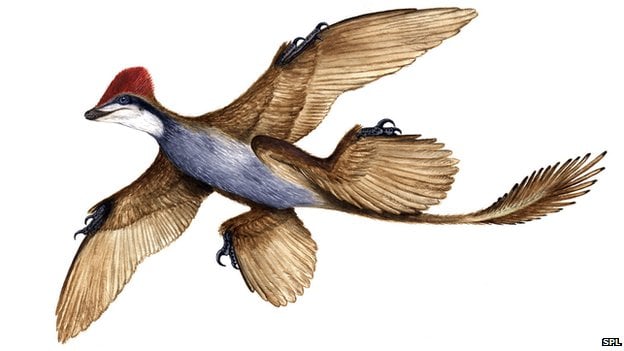D
Deleted member 21043
Thread author
- Content source
- http://www.bbc.co.uk/news/science-environment-28295571
A new four-winged dinosaur has been discovered, with exceptionally long feathers on its tail and "hindwings".
Changyuraptor yangi was a gliding predator which lived in the Cretaceous period in what is now Liaoning, China.
Its remarkable tail feathers - measuring up to 30cm - are the longest in any non-avian dinosaur.
Continue reading the main story
“Start Quote
The tail would have acted as a pitch control structure reducing descent speed... which could be critical to a safe landing or precise attack on prey”
Lizhuo Han Bohai University, China
This unusual plumage helped the creature to slow down during flight and land safely, say scientists writing in Nature Communications.
C. yangi is a new species of microraptorine, a group related to early avians.
These ancient creatures offer clues to the origin of flight - and the transition from feathered dinosaurs to birds.
Palaeontologists once thought that four-winged gliders were a stepping stone in the path to two-winged flight.
But recent fossil discoveries suggest that microraptorines were an evolutionary side-branch.
Flight probably evolved many times in different feathered species - not only the lineage which ultimately became birds.
 Microraptor gui - another ancient four-winged species
Microraptor gui - another ancient four-winged species
The skeleton of C. yangi was discovered by a team from Bohai University, China, and the Natural History Museum of Los Angeles County, US.
Measuring 132cm from its snout to the tip of its tail feathers, it is the largest four-winged dinosaur ever discovered - longer than an eagle or an albatross today.
The feathers on its hind limbs are unusually prominent - suggesting they were actually "hindwings" and played a role in flight, the researchers write.
By calculating the lift and drag generated by the feathers, they concluded that C. yangi used its long tail to compensate for its large size and maintain control while airborne.
"The low-aspect-ratio tail of the new fossil would have acted as a pitch control structure reducing descent speed... which could be critical to a safe landing or precise attack on prey," the authors write.
"Such pitch stabilisation could be particularly important for larger microraptorines (since they would tend to fly and/or descend more rapidly than small individuals), and this effect explains why the tail fan is exceptionally long."
Changyuraptor yangi was a gliding predator which lived in the Cretaceous period in what is now Liaoning, China.
Its remarkable tail feathers - measuring up to 30cm - are the longest in any non-avian dinosaur.
Continue reading the main story
“Start Quote
The tail would have acted as a pitch control structure reducing descent speed... which could be critical to a safe landing or precise attack on prey”
Lizhuo Han Bohai University, China
This unusual plumage helped the creature to slow down during flight and land safely, say scientists writing in Nature Communications.
C. yangi is a new species of microraptorine, a group related to early avians.
These ancient creatures offer clues to the origin of flight - and the transition from feathered dinosaurs to birds.
Palaeontologists once thought that four-winged gliders were a stepping stone in the path to two-winged flight.
But recent fossil discoveries suggest that microraptorines were an evolutionary side-branch.
Flight probably evolved many times in different feathered species - not only the lineage which ultimately became birds.

The skeleton of C. yangi was discovered by a team from Bohai University, China, and the Natural History Museum of Los Angeles County, US.
Measuring 132cm from its snout to the tip of its tail feathers, it is the largest four-winged dinosaur ever discovered - longer than an eagle or an albatross today.
The feathers on its hind limbs are unusually prominent - suggesting they were actually "hindwings" and played a role in flight, the researchers write.
By calculating the lift and drag generated by the feathers, they concluded that C. yangi used its long tail to compensate for its large size and maintain control while airborne.
"The low-aspect-ratio tail of the new fossil would have acted as a pitch control structure reducing descent speed... which could be critical to a safe landing or precise attack on prey," the authors write.
"Such pitch stabilisation could be particularly important for larger microraptorines (since they would tend to fly and/or descend more rapidly than small individuals), and this effect explains why the tail fan is exceptionally long."

